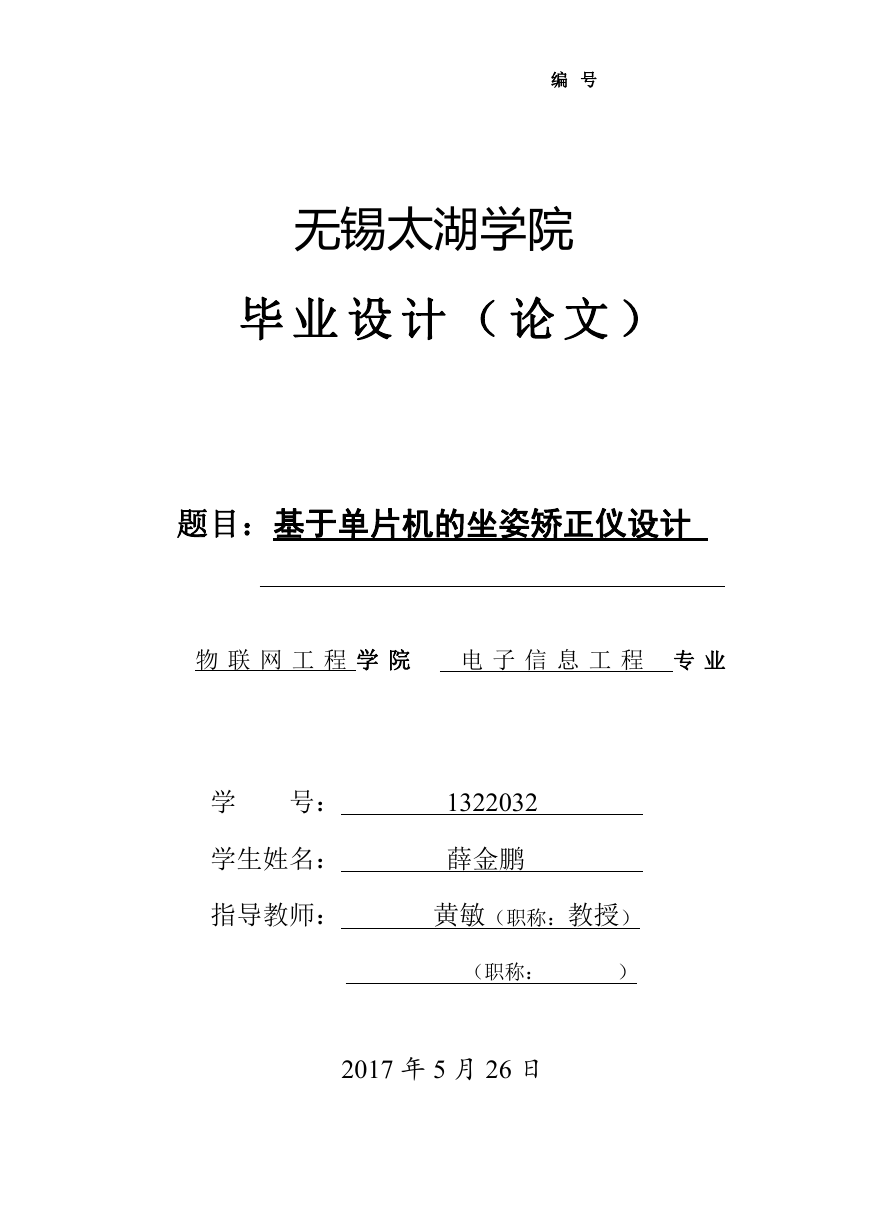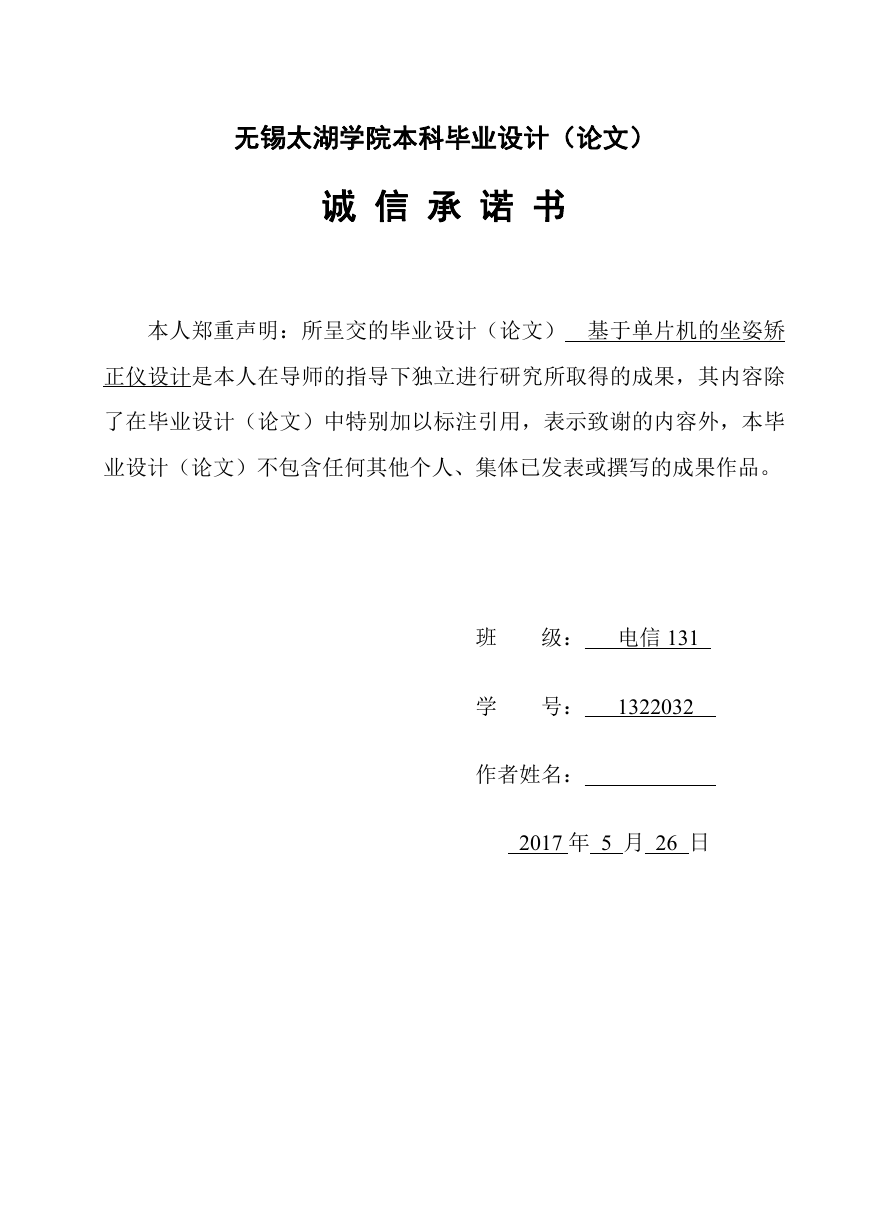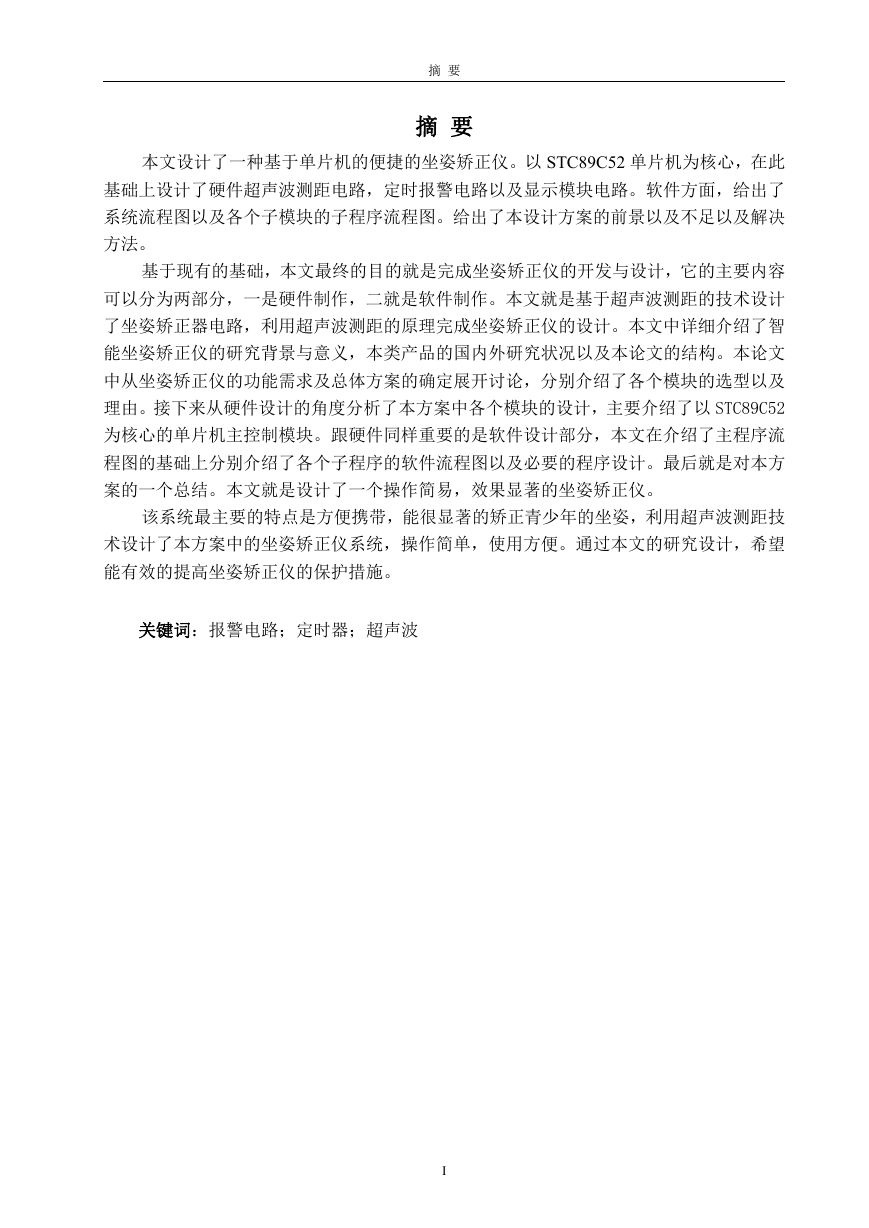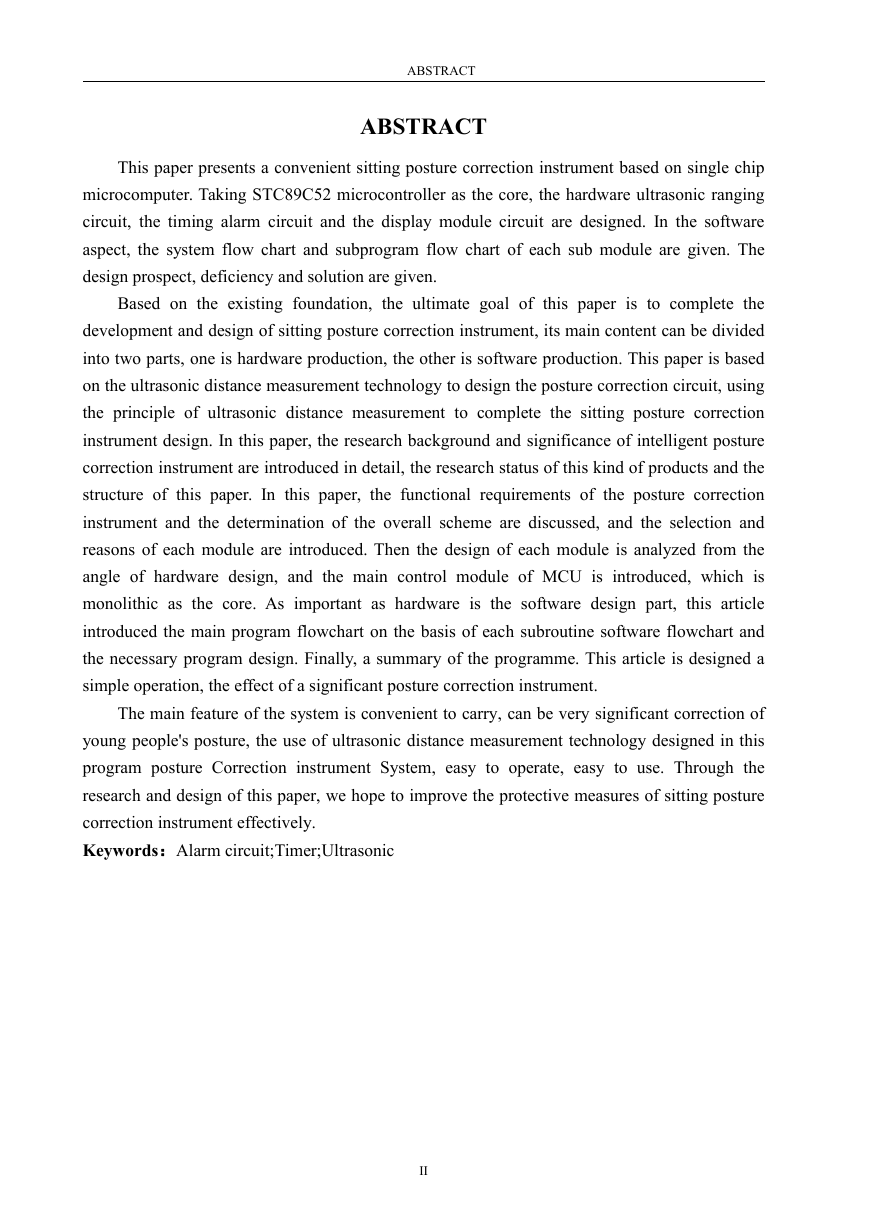编 号
无锡太湖学院
毕 业 设 计 ( 论 文 )
题目:基于单片机的坐姿矫正仪设计
物 联 网 工 程 学 院
电 子 信 息 工 程 专 业
学
号:
1322032
学生姓名:
薛金鹏
指导教师:
黄敏(职称:教授)
(职称:
)
2017 年 5 月 26 日
�
�
无锡太湖学院本科毕业设计(论文)
诚 信 承 诺 书
本人郑重声明:所呈交的毕业设计(论文) 基于单片机的坐姿矫
正仪设计是本人在导师的指导下独立进行研究所取得的成果,其内容除
了在毕业设计(论文)中特别加以标注引用,表示致谢的内容外,本毕
业设计(论文)不包含任何其他个人、集体已发表或撰写的成果作品。
班 级: 电信 131
学 号: 1322032
作者姓名:
2017 年 5 月 26 日
�
�
摘 要
摘 要
本文设计了一种基于单片机的便捷的坐姿矫正仪。以 STC89C52 单片机为核心,在此
基础上设计了硬件超声波测距电路,定时报警电路以及显示模块电路。软件方面,给出了
系统流程图以及各个子模块的子程序流程图。给出了本设计方案的前景以及不足以及解决
方法。
基于现有的基础,本文最终的目的就是完成坐姿矫正仪的开发与设计,它的主要内容
可以分为两部分,一是硬件制作,二就是软件制作。本文就是基于超声波测距的技术设计
了坐姿矫正器电路,利用超声波测距的原理完成坐姿矫正仪的设计。本文中详细介绍了智
能坐姿矫正仪的研究背景与意义,本类产品的国内外研究状况以及本论文的结构。本论文
中从坐姿矫正仪的功能需求及总体方案的确定展开讨论,分别介绍了各个模块的选型以及
理由。接下来从硬件设计的角度分析了本方案中各个模块的设计,主要介绍了以 STC89C52
为核心的单片机主控制模块。跟硬件同样重要的是软件设计部分,本文在介绍了主程序流
程图的基础上分别介绍了各个子程序的软件流程图以及必要的程序设计。最后就是对本方
案的一个总结。本文就是设计了一个操作简易,效果显著的坐姿矫正仪。
该系统最主要的特点是方便携带,能很显著的矫正青少年的坐姿,利用超声波测距技
术设计了本方案中的坐姿矫正仪系统,操作简单,使用方便。通过本文的研究设计,希望
能有效的提高坐姿矫正仪的保护措施。
关键词:报警电路;定时器;超声波
I
�
ABSTRACT
ABSTRACT
This paper presents a convenient sitting posture correction instrument based on single chip
microcomputer. Taking STC89C52 microcontroller as the core, the hardware ultrasonic ranging
circuit, the timing alarm circuit and the display module circuit are designed. In the software
aspect, the system flow chart and subprogram flow chart of each sub module are given. The
design prospect, deficiency and solution are given.
Based on the existing foundation, the ultimate goal of this paper is to complete the
development and design of sitting posture correction instrument, its main content can be divided
into two parts, one is hardware production, the other is software production. This paper is based
on the ultrasonic distance measurement technology to design the posture correction circuit, using
the principle of ultrasonic distance measurement to complete the sitting posture correction
instrument design. In this paper, the research background and significance of intelligent posture
correction instrument are introduced in detail, the research status of this kind of products and the
structure of this paper. In this paper, the functional requirements of the posture correction
instrument and the determination of the overall scheme are discussed, and the selection and
reasons of each module are introduced. Then the design of each module is analyzed from the
angle of hardware design, and the main control module of MCU is introduced, which is
monolithic as the core. As important as hardware is the software design part, this article
introduced the main program flowchart on the basis of each subroutine software flowchart and
the necessary program design. Finally, a summary of the programme. This article is designed a
simple operation, the effect of a significant posture correction instrument.
The main feature of the system is convenient to carry, can be very significant correction of
young people's posture, the use of ultrasonic distance measurement technology designed in this
program posture Correction instrument System, easy to operate, easy to use. Through the
research and design of this paper, we hope to improve the protective measures of sitting posture
correction instrument effectively.
Keywords:Alarm circuit;Timer;Ultrasonic
II
�
目 录
目 录
摘 要............................................................................................................................................... I
ABSTRSCT....................................................................................................................................II
目录...............................................................................................................................................III
第 1 章 绪论............................................................................................................................... 1
1.1 课题研究的背景及意义.................................................................................................1
1.1.1 研究意义...............................................................................................................1
1.1.2 研究背景...............................................................................................................1
1.2 国内外研究现状.............................................................................................................2
1.3 本课题应达到的要求.....................................................................................................3
第 2 章 坐姿矫正仪的总体方案设计....................................................................................... 5
2.1 总体方案的功能及需求...................................................................................................5
2.2 总体方案的确定.............................................................................................................5
2.3 系统方案选型的具体选择.............................................................................................5
2.3.1 电源模块...............................................................................................................5
2.3.2 主控制器模块.........................................................................................................6
2.3.3 报警模块...............................................................................................................7
2.3.4 坐姿检测模块.......................................................................................................8
2.3.5 显示模块...............................................................................................................9
第 3 章 坐姿矫正仪系统的硬件设计..................................................................................... 11
3.1 坐姿矫正仪的系统设计..................................................................................................11
3.1.1 STC89C52 单片机模块.........................................................................................11
3.1.2 主控制模块电路.................................................................................................11
3.2 外围子模块电路设计.....................................................................................................13
3.2.1 电源电路的设计...................................................................................................13
3.2.2 蜂鸣器驱动电路的设计........................................................................................13
3.2.3 显示模块电路设计...............................................................................................14
3.2.4 报警电路模块设计...............................................................................................15
3.3 超声波坐姿测距模块...................................................................................................16
3.3.1 超声波的基本特性.............................................................................................17
3.3.2 超声波测距模块的工作原理...............................................................................18
第 4 章 坐姿矫正仪系统的软件设计..................................................................................... 19
4.1 坐姿矫正仪的基本流程图.............................................................................................19
4.2 外围电路模块的软件设计.............................................................................................19
4.2.1 超声波测距模块的软件设计...............................................................................19
4.2.2 报警模块的软件设计...........................................................................................21
4.2.3 LCD 显示模块的软件设计................................................................................23
4.3 仿真图.............................................................................................................................25
III
�
目 录
第 5 章 结论与展望................................................................................................................. 27
5.1 结论.................................................................................................................................27
5.2 展望.................................................................................................................................27
参考文献.......................................................................................................................................29
致 谢.............................................................................................................................................31
IV
�
















 2023年江西萍乡中考道德与法治真题及答案.doc
2023年江西萍乡中考道德与法治真题及答案.doc 2012年重庆南川中考生物真题及答案.doc
2012年重庆南川中考生物真题及答案.doc 2013年江西师范大学地理学综合及文艺理论基础考研真题.doc
2013年江西师范大学地理学综合及文艺理论基础考研真题.doc 2020年四川甘孜小升初语文真题及答案I卷.doc
2020年四川甘孜小升初语文真题及答案I卷.doc 2020年注册岩土工程师专业基础考试真题及答案.doc
2020年注册岩土工程师专业基础考试真题及答案.doc 2023-2024学年福建省厦门市九年级上学期数学月考试题及答案.doc
2023-2024学年福建省厦门市九年级上学期数学月考试题及答案.doc 2021-2022学年辽宁省沈阳市大东区九年级上学期语文期末试题及答案.doc
2021-2022学年辽宁省沈阳市大东区九年级上学期语文期末试题及答案.doc 2022-2023学年北京东城区初三第一学期物理期末试卷及答案.doc
2022-2023学年北京东城区初三第一学期物理期末试卷及答案.doc 2018上半年江西教师资格初中地理学科知识与教学能力真题及答案.doc
2018上半年江西教师资格初中地理学科知识与教学能力真题及答案.doc 2012年河北国家公务员申论考试真题及答案-省级.doc
2012年河北国家公务员申论考试真题及答案-省级.doc 2020-2021学年江苏省扬州市江都区邵樊片九年级上学期数学第一次质量检测试题及答案.doc
2020-2021学年江苏省扬州市江都区邵樊片九年级上学期数学第一次质量检测试题及答案.doc 2022下半年黑龙江教师资格证中学综合素质真题及答案.doc
2022下半年黑龙江教师资格证中学综合素质真题及答案.doc